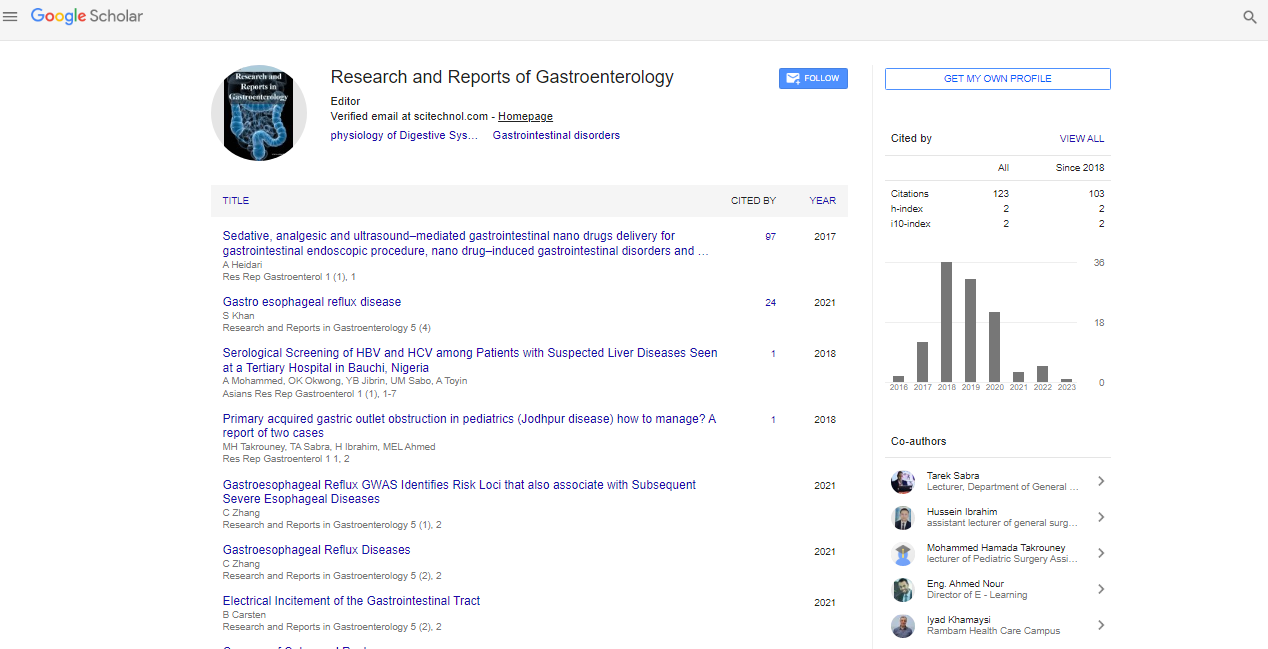Perspective, Res Rep Gastroenterol Vol: 7 Issue: 1
Digestion Absorption
Simiheer Khan*
Department of Gastroenterology, Graduate School of Medicine, Tokyo, Japan
*Corresponding Author: Simiheer Khan
Department of Gastroenterology, Graduate School of Medicine, Tokyo, Japan
E-mail: khan90@gmail.com
Received date: 20 February, 2023, Manuscript No. RRG-23-97822;
Editor assigned date: 22 February, 2023, PreQC No. RRG-23-97822 (PQ);
Reviewed date: 08 March, 2023, QC No. RRG-23-97822;
Revised date: 15 March, 2023, Manuscript No. RRG-23-97822 (R);
Published date: 23 March, 2023, DOI: 10.4172/Rrg.1000133
Citation: Khan S (2023) Gastro Esophageal Reflux Disease. Res Rep Gastroenterol 7:1.
Description
Digestion and absorption are two crucial processes that allow our bodies to extract nutrients from the food we eat and use them for energy and other functions. The digestive system is a complex network of organs and tissues that work together to break down food into smaller molecules that can be absorbed by the body. In this article, we will explore the process of digestion and absorption, including the organs involved and the different types of nutrients that are absorbed.
The digestive process begins in the mouth, where food is broken down by the action of teeth and saliva. Saliva contains enzymes that help to break down carbohydrates and initiate the digestion process. From the mouth, food travels down the esophagus and into the stomach, where it is mixed with digestive enzymes and stomach acid. The acid helps to break down proteins, while the enzymes work to break down carbohydrates and fats.
After spending several hours in the stomach, the partially digested food moves into the small intestine. This is where the majority of nutrient absorption takes place. The small intestine is a long, narrow tube that is lined with millions of tiny finger-like projections called villi. These villi increase the surface area of the small intestine, allowing for more efficient absorption of nutrients.
Types of nutrients absorbed
There are several types of nutrients that are absorbed during the digestive process. These include:
Carbohydrates: Carbohydrates are one of the main sources of energy for the body. They are broken down into simple sugars such as glucose, which can be absorbed by the body and used for energy.
Proteins: Proteins are essential for building and repairing tissues in the body. They are broken down into individual amino acids, which can be absorbed and used by the body.
Fats: Fats are an important source of energy and play a vital role in the absorption of certain vitamins. They are broken down into fatty acids and glycerol, which can be absorbed by the body and used for energy or stored for later use.
Vitamins: Vitamins are essential nutrients that the body needs in small amounts to function properly. They are absorbed in the small intestine and play a variety of roles in the body, including immune function, bone health, and energy production.
Minerals: Minerals are essential nutrients that the body needs in small amounts for various functions, including building strong bones and teeth, regulating the heartbeat, and maintaining fluid balance in the body.
Organs involved in digestion and absorption
Several organs are involved in the digestive and absorption process, including:
Mouth: The mouth is where digestion begins, as food is broken down by teeth and saliva.
Esophagus: The esophagus is a muscular tube that connects the mouth to the stomach and transports food to the stomach.
Stomach: The stomach is where food is mixed with digestive enzymes and stomach acid to begin the process of breaking down proteins, fats, and carbohydrates.
Small intestine: The small intestine is where the majority of nutrient absorption takes place. The small intestine is a long, narrow tube that is lined with villi to increase the surface area for nutrient absorption.
Large intestine: The large intestine is where water is absorbed from undigested food, and waste is eliminated from the body.
In conclusion, digestion and absorption are essential processes that allow our bodies to extract nutrients from the food we eat and use them for energy and other functions. Understanding how these processes work can help us make informed decisions about our diets and overall health.
 Spanish
Spanish  Chinese
Chinese  Russian
Russian  German
German  French
French  Japanese
Japanese  Portuguese
Portuguese  Hindi
Hindi 